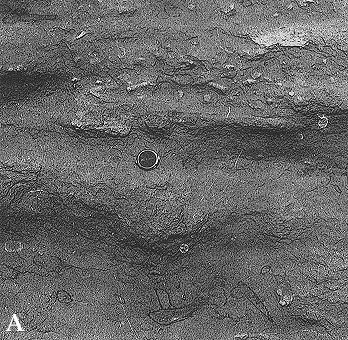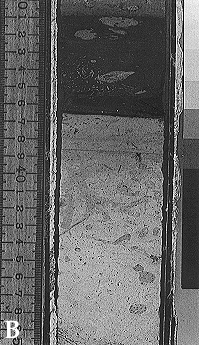

Diffuse bioturbation and burrow traces
Plate 146


Diffuse bioturbation and burrow traces
Plate 146
The outcrop shown in plate 146 A is made of clayey-silty sandstone, whose bedding has been almost entirely obliterated by burrowing organisms: only "ghosts" of the original beds are visible (as in plates 20-22). The bioturbation was pervasive and led to homogenization, or biological amalgamation of distinct lithotypes. Notwithstanding that, individual structures can be seen in both the lower and upper part of the section. They are called, in general, trace fossils (or ichnofossils ) to distinguish them from body fossils. Various types of traces can be recognized in Modern and Ancient sediments; they are classified by diverse criteria, such as the organism ecology and physiology, the trace morphology, its location and orientation with respect to bedding planes. Many traces were mistaken for real fossils, and received generic and specific names according to Linnean rules of paleontological taxonomy.
Coming back to picture A, two types of burrows occur in these "dirty" sands, which were deposited in a littoral (shoreface) environment of Pliocene age (compare with plate 21). Lower burrows are outlined by a black coating of manganese oxides; their shape varies depending on the orientation with regard to the section. The upper burrows stand out because of cementation; they are smaller and more cylindrical, and were clearly made by a different type of animal. Curiously, they resemble "macaroni" pasta, which induced somebody to propose the name Macaronichnus for very similar structures found in Miocene sediments of northern California.
Pliocene Intra-apenninic Basin, Zena Valley, northern Apennines.
Plate 146 B shows, for comparison, a two-layered core, with burrow density increasing near the top of the light layer. What is the meaning of this variation? The white-black interface is probably the top of a rapidly accumulating bed (no traces are present in its lower part). It remained exposed for a while and was populated by benthic organisms that reworked the topmost part of the previous deposit. Penetration was less easy as soon as the burrowers approached the critical depth, where traces become scanty.
The darker mud at the top of the core accumulated more slowly, and was bioturbated throughout.